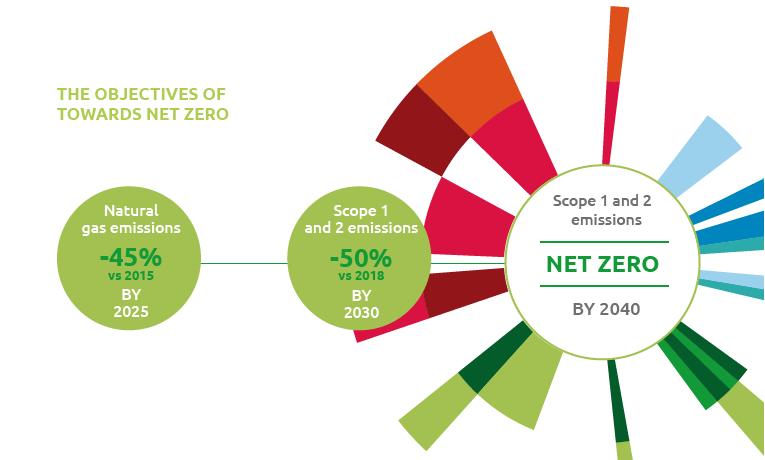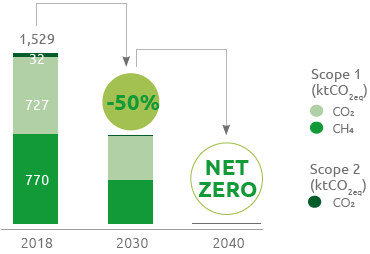Carbon neutrality
With its Net Zero Carbon strategy, Snam envisages concrete actions and significant investments for a gradual reduction in direct and indirect energy emissions of Scope 1 and 2 greenhouse gases, in line with the commitments defined in the Paris Agreement to limit the rise in global temperature to no more than 1.5°C, until carbon neutrality is achieved in 2040. In order to substantiate and trace the path towards Net Zero Carbon, Snam has planned clear intermediate steps in the short and medium term:
- By 2025: reduction of natural gas emissions by -45% compared to 2015 values, in accordance with the UNEP Oil & Gas Methane Partnership initiative (OGMP);
- By 2030: reduction of Scope 1 and 2 greenhouse gas emissions by -50% compared to 2018 values;
- By 2040: carbon neutrality for Scope 1 and 2 greenhouse gas emissions.
Net zero emissions will be achieved through the reduction of emissions associated with operational activities (Scope 1 and 2), which mainly consist of measures to contain methane (CH4) emissions, through the modernisation, efficiency and maintenance of the network, and the reduction of carbon dioxide (CO2) emissions, thanks to the conversion of compressor stations to dual fuels, thus replacing gas turbocompressors with electric compressors, and the use of green electricity. In addition, with a view to integrating hydrogen into the existing infrastructure and thus enabling its use, about half of the investments envisaged in the Strategic Plan will be geared towards continuing the adaptation of the existing network to hydrogen ready, which is already 70% ready today. Snam also plans to install the first hybrid turbine capable of operating with 10% hydrogen at the Istrana (TV) power plant in 2021. Finally, for emissions that cannot be eliminated, offsetting measures will be implemented through offsetting projects.
A commitment to reduce other indirect GHG emissions (Scope 3) was also declared, primarily by working with participated companies and suppliers to reduce emissions throughout the entire value chain.

SCOPE 1 AND 2 EMISSIONS
TARGET:

WHAT ARE SNAM’S SCOPE 1 AND 2 EMISSIONS?
Direct emissions (Scope 1)
- Methane emissions resulting from Snam’s various businesses such as transport, storage and regasification
- Emissions due to Snam’s direct consumptions, such as natural gas used in the combustion of industrial processes and for heating offices, and other fuels such as diesel oil, gasoline and LPG
- Emissions of HFC (not relevant), used in air conditioning systems
Energy indirect emissions (Scope 2)
-
Indirect emissions for the production of electricity and steam produced by third parties and which Snam uses for its own activities
ACTIONS TO ACHIEVE THE CHALLENGES
Reduction of emissions from operations
- Interventions and application of best practices to minimise CH4 emissions
- Reducing CO2 emissions and Group’s energy needs, also thanks to the installation of new electric compressors in the gas booster and storage plants
- Use of renewable electricity
Development of green gases
- Development and networking of new green gases, such as biomethane and hydrogen
Reduction of emissions from buildings and the company car fleet
- Planning a move to a new headquarter certified LEED GOLD
- Use of green electricity produced by photovoltaic plants
- Conversion of company fleet to natural gas vehicles
SCOPE 3 EMISSIONS
TARGET:
Reducing other indirect GHG emissions (Scope 3) along the entire value chain by working primarily with participated companies and suppliers.
WHAT ARE SNAM’S SCOPE 3 EMISSIONS?
Other indirect emissions (Scope 3)
- Emissions from the supply chain
- Scope emissions 1 and Scope 2 emissions of participated companies
- Emissions from business travels and employees’ commuting
- Emissions from extraction and network losses of natural gas and electricity
ACTIONS TO ACHIEVE THE CHALLENGE
Definition of a reduction plan for the main Scope 3 emission categories:
Suppliers
- Mapping of greenhouse gas emissions of all suppliers
- Request for compilation, to the most significant suppliers in terms of procurement, of the CDP Supply Chain questionnaire (formerly the Carbon Disclosure Project)
Participated Companies
- Workshops and training for sharing best practices, also involving their own commercial partners, as well as members
- Launch of awareness-raising projects to encourage participated companies to take action to reduce their methane leakages, pneumatic emissions and to use electricity from renewable sources
Snam’s infrastructure has always supported the Italian economy by expanding and maintaining the network, heating millions of homes and contributing to the country’s energy security. Thanks to its assets, know-how and belief in the importance of acting responsibly, Snam is aware of its role and the opportunity it has to make a significant contribution to reducing greenhouse gas emissions for the entire country system. This is the direction in which we have been working in recent years, developing the network for the production and distribution not only of natural gas, but also of biomethane and hydrogen, which are essential for reducing the use of fossil fuels, with continuous modernisation of the network from a hydrogen-ready perspective to provide the country with state-of-the-art infrastructure, ready to receive the new energy source.
Moreover, thanks to business initiatives in energy efficiency and sustainable mobility, Snam is contributing to the modernisation of the country’s most structural components, such as buildings and transport.

Snam-Terna scenarios underlying Towards Net Zero
In order to outline the objectives and timeframes underlying the Towards Net Zero strategy, Snam, through the elaboration of forecast energy scenarios, has defined the possible evolutions of the Italian energy system in the medium-long term (2030, 2040 and 2050). In doing so, the Group took into account European and national climate targets in order both to ensure that its strategy was in line with them and to verify that the targets set out in the Strategic Plan were sufficiently ambitious.
In particular, the strategy is based on the three scenarios identified in collaboration with Terna in 2019, contained in the “2019 Scenarios Description Document”, and which determine the gas supply and demand projections to 2040. These scenarios are:
- Business-As-Usual (BAU), which projects current trends and features technological development based on economic merit alone;
- Centralized (CEN), in which the 2030 decarbonisation targets, renewable energy sources and energy efficiency quota and non-binding guidelines to reduce long-term CO2 emissions are achieved by curbing consumption and the development of programmable renewable energies such as green gases, using existing gas infrastructures;
- Decentralised (DEC), in which, thanks to an even faster development of the electricity carrier and non-programmable RES, the 2030 decarbonisation targets, the RES and energy efficiency quota and the non-binding long-term CO2 emission reduction targets are achieved.
For more information on the scenarios underlying the Towards Net Zero strategy, see the chapter “The context and reference scenarios” in the document “Financial Disclosure on Climate Change 2020”